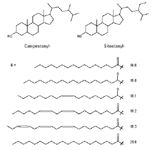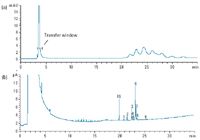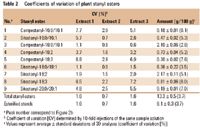Analysis of Plant Stanyl Fatty Acid Esters in Enriched Margarine Using an Online Coupled Agilent 1220 Infinity LC-7890 GC System
The work described here involved the investigation of intact plant stanyl fatty acid esters in an enriched commercial margarine using an online coupled Agilent 1220 Infinity LC-7890A GC system. The lipid extract was directly analyzed without prior purification steps. The LC fraction of plant stanyl esters was transferred online into the GC system using the solvent vent mode of the multimode inlet for solvent evaporation.
Andreas Barnsteiner, Rebecca Esche, Karl-Heinz Engel, Munich Technical University, Freising, Germany.
Walter Kohlert, Stefan Fenzel, Agilent Technologies, Inc., Waldbronn, Germany.
ABSTRACT
The work described here involved the investigation of intact plant stanyl fatty acid esters in an enriched commercial margarine using an online coupled Agilent 1220 Infinity LC-7890A GC system. The lipid extract was directly analyzed without prior purification steps. The LC fraction of plant stanyl esters was transferred online into the GC system using the solvent vent mode of the multimode inlet for solvent evaporation. The online LC-GC combination showed very good linearity and repeatability.
INTRODUCTION
Plant steryl and stanyl esters (Figure 1) are added to food products like skimmed milk-drinking yogurts or margarines because of their cholesterol-lowering properties. The capillary gas chromatographic investigation of plant stanyl fatty acid esters from skimmed milk products can be performed directly after the lipid extraction1. However, the presence of di- and triglycerides may hamper the direct GC quantification. Therefore, the analysis in lipid extracts from foods with high fat contents like margarine requires a fractionation prior to the GC separation by laborious offline techniques, such as Thin Layer Chromatography (TLC) or Solid Phase Extraction (SPE). The online coupling of LC and GC offers an efficient and elegant alternative. The plant stanyl esters can be fractionated by liquid chromatography and transferred online into the GC system. In this way, the pre-fractionation step and the capillary gas chromatographic analysis of the transferred LC fraction are performed in a closed system in one run. Hence, the risk of sample loss and contamination is reduced and the approach results in better repeatability2, 3.

Figure 1. Structures of plant stanyl fatty acid esters
In a recently published paper1, the analysis of plant stanyl esters in enriched margarines using an online LC-GC system equipped with a loop-type interface was reported. Using the loop-type interface, the solvent evaporation was performed in the GC capillary columns by means of a pre-column system in combination with an early solvent vapor exit. Due to the high solvent amounts which were loaded on the pre-column system with each transfer, a loss of resolution was observed after a few runs.
The online coupling of an Agilent 1220 Infinity LC system and an Agilent 7890A GC system, with a 2-position/6-port switching valve using the solvent vent mode of the multimode inlet of the GC, allowed for the evaporation of the solvent prior to the capillary column4. A pre-column system and/or a solvent vapor exit were not necessary. This combination was already suitable for the analysis of cholesteryl esters4.
The use of an Agilent online coupled LC-GC combination for the quantification of plant stanyl esters in enriched margarine is presented here.
EXPERIMENTAL
Chemicals and materials
The plant stanyl ester mixture "plant stanol ester, STAEST-115" was provided by Raisio Group (Raisio, Finland). The internal standard cholesteryl palmitate (≥ 98%) was obtained from Sigma Aldrich (Taufkirchen, Germany).
Benecol (taste-type Kevyt kasvirasvalevite 32%, with added plant stanyl esters) margarine was purchased in a supermarket in Finland. The plant stanol content was labeled as 8 wt-%, total lipids as 32 wt-%.
SAMPLE PREPARATION OF MARGARINE1
The margarine sample (20–40 mg, accuracy of ± 0.1 mg) was weighed into a vessel; internal standard (cholesteryl palmitate, 750 μg), 5 mL of n-hexane/MTBE (3:2) and sodium sulfate (anhydrous) were added and sonicated for 1 minute. The solution was filtered through a 0.45 μm membrane filter assembled with a 5 mL syringe. The vessel and the filter were washed twice with 5 mL n-hexane/MTBE (3:2). After dilution (1:5) of the combined extracts, the solution was used for online LC-GC analysis.
QUANTIFICATION
The five-point calibration functions of nine individual stanyl esters were generated in a range of 0.2 – 1.0 μg of total stanyl ester ("plant stanol ester, STAEST-115") per 2 μL i.v. Each calibration point was done in triplicate. Linear regression analysis was performed in coordinate ratios of areas (individual stanyl ester/IS) and amounts (individual stanyl ester/IS).
EQUIPMENT
The coupling of the Agilent 1220 Infinity LC system to the Agilent 7890A GC system was accomplished using an Agilent 2-position/6-port switching valve equipped with a 200 μL sample loop (Table 1). The evaporation of the eluent was performed using the temperature programmable MultiMode (MM) Inlet in the Programmable-Temprature Vaporizing (PTV) solvent vent mode4.

Table 1. Liquid and gas chromatographic conditions
RESULTS AND DISCUSSION
The chromatograms obtained by online LC-GC analysis of a margarine enriched with plant stanyl esters are presented in Figure 2. The LC-fractionation (Figure 2a) was performed isocratically on a silica gel column with n-hexane/MTBE (96+4; v+v) as mobile phase. The plant stanyl esters eluted after approximately 4 minutes. The transfer was performed 4.25 minutes after injection. The transfer conditions for the analysis of cholesteryl esters4 were also suitable for plant stanyl esters. The GC separation of the transferred fraction was similar to that reported for the online LC-GC analysis via a loop-type interface1. The intact plant stanyl fatty acid esters were distinguishable according to their carbon number and, in the case of unsaturated fatty acid moieties, to the number of double bonds; only the esters of saturated and monounsaturated fatty acids of the same chain length eluted at the same time.

Figure 2. Analysis of plant stanyl esters in enriched margarine by online LC-GC/FID; (a) LC-chromatogram and (b) GC-chromatogram of the transferred LC-fraction; peak numbering according to Table 2; (IS) internal standard cholesteryl palmitate
Under the employed online LC-GC conditions, using the Agilent Multimode Inlet for the solvent evaporation4, the solvent load on the GC capillaries was low in comparison to the loop-type coupled system. Even after 600 transfers, no loss of resolution was observed using the online LC-GC combination.
For the calibration, linear regression analysis was performed in the coordinate ratios of areas (individual stanyl ester/IS) and amounts (individual stanyl ester/IS). The correlation coefficients of the calculated calibration functions (R2) were in the range of 0.995 – 0.999, showing very good linearity of the online LC-GC/FID detector response.
The repeatability was determined by 10-fold injections of the same sample solution. The coefficients of variation were low (< 9%) for all plant stanyl esters (Table 2). The quantitative results were comparable to those obtained by means of the loop-type interface coupled online LC-GC1.

Table 2 Coefficients of variation of plant stanyl esters
CONCLUSION
Online coupling of an Agilent 1220 Infinity LC system and an Agilent 7890A GC system was shown to be suitable for the quantitative analysis of plant stanyl fatty acid esters in enriched margarine. The online LC-GC system was characterized by easy handling and a very robust separation performance for both dimensions. Therefore, the Agilent online LC-GC combination can be a valuable tool for the routine analysis of plant steryl and stanyl esters in functional foods.
REFERENCES
(1) A. Barnsteiner, T. Lubinus, A. di Gianvito, W. Schmid, K.-H. Engel, GC-Based Analysis of Plant Stanyl Fatty Acid Esters in Enriched Foods. Journal of Agricultural and Food Chemistry, 2011, 59, (10), 5204-5214.
(2) P. Dugo, G. Dugo, L. Mondello, On-line coupled LC-GC: theory and applications. LC-GC Eur. 2003, 16, (12a), 35-43.
(3) T. Hyoetylaeinen, M.-L. Riekkola, On-line coupled liquid chromatography-gas chromatography. J Chromatogr A 2003, 1000, (1-2), 357-84.
(4) R. Esche, A. Barnsteiner, K.-H. Engel, W. Kohlert, S. Fenzel, Two-dimensional chromatography: LC-GC online coupling of on Agilent 1260 Infinity LC and an Agilent 7890A GC, Agilent Technical Overview, publication number 5990-8025EN; 2011
Agilent shall not be liable for errors contained herein or for incidental or consequential damages in connection with the furnishing, performance, or use of this material. Information, descriptions, and specifications in this publication are subject to change without notice.
Removing Double-Stranded RNA Impurities Using Chromatography
April 8th 2025Researchers from Agency for Science, Technology and Research in Singapore recently published a review article exploring how chromatography can be used to remove double-stranded RNA impurities during mRNA therapeutics production.
The Effect of Time and Tide On PFAS Concentrations in Estuaries
April 8th 2025Oliver Jones and Navneet Singh from RMIT University, Melbourne, Australia discuss a recent study they conducted to investigate the relationship between tidal cycles and PFAS concentrations in estuarine systems, and offer practical advice on the sample preparation and LC–MS/MS techniques they used to achieve the best results.





